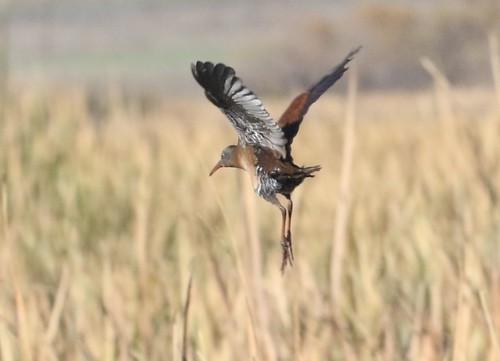Virginia Rail
A species of Greater Rails Scientific name : Rallus limicola Genus : Greater Rails
Virginia Rail, A species of Greater Rails
Botanical name: Rallus limicola
Genus: Greater Rails
Content
Description People often ask General Info
 Photo By silversea_starsong , used under CC-BY-NC-4.0 /Cropped and compressed from original
Photo By silversea_starsong , used under CC-BY-NC-4.0 /Cropped and compressed from original Description
Adults are mainly brown, darker on the back and crown, with orange-brown legs. To walk through dense vegetation, they have evolved a laterally compressed body and strong forehead feathers adapted to withstand wear from pushing through vegetation. Virginia rails have the highest ratio of leg-muscle to flight-muscle of all birds (25% - 15% of body weight respectively). They have long toes used to walk on floating vegetation. Their tail is short and they have a long slim reddish bill. Their cheeks are grey, with a light stripe over the eye and a whitish throat. Chicks are black. Juveniles are blackish brown on upperparts with rufous on the edge of feathers and brownish bill and legs. Their underparts are dark brown to black, while the face is grayish brown. Both sexes are very similar, with females being slightly smaller. Adults measure 20–27 cm, with a wingspan of 32–38 cm, and usually weigh 65-95 g. 
Size
23-25 cm (9-10 in)
Colors
Brown
Gray
Orange
Life Expectancy
2-5 years
Nest Placement
Ground
Clutch Size
4 - 13 eggs
Incubation Period
1 - 2 broods
Number of Broods
18 - 20 days
Nestling Period
3 - 4 days
Feeding Habits
Virginia Rail's diet includes beetles, snails, spiders, flies, fish, slugs, crayfish, and frogs. In winter, it adds aquatic invertebrates, plant material, and seeds. Virginia Rail forages in muddy wetlands at dawn and dusk, probing for prey.
Habitat
Virginia Rail thrives in freshwater wetlands and brackish marshes that feature robust emergent vegetation such as cattails and rushes. Preferring shallow waters with depths less than 6 inches and muddy bottoms, they seek environments where tall emergent vegetation covers 40–70%, interspersed with open water and mudflats. While predominantly situated in freshwater habitats, virginia Rail also navigates deeper wetlands and coastal salt marshes, extending into more open territories during the nonbreeding season.
Nest Behavior
Nest building by virginia Rail takes about a week, performed by both sexes. Following construction, egg-laying and parental care are shared responsibilities.
Nest Characteristics
Virginia Rail typically construct nests within wetland vegetation, favoring materials like cattails and bulrushes. Their nests rest on floating mats just above the water surface, forming a loosely woven basket, sometimes with an overhead canopy.
Dite type
Aquatic invertebrate eater
People often ask
General Info
Feeding Habits
Bird food type
Sounds
Call
Recording location: Mexico
Call
Recording location: Mexico
Behavior
Virginia Rail exhibit strong terrestrial prowess, adeptly maneuvering through dense wetland vegetation thanks to their robust legs and elongated toes. Their slender build facilitates stealthy movement, often accompanied by distinctive tail flicking. Typically reclusive, virginia Rail remain solitary outside of mating season, when they establish monogamous pairs and ardently protect their domains through vocal displays. Though predominantly ground-dwellers, they demonstrate occasional aquatic proficiency, diving and swimming when necessary. Flight is generally reserved for migration, as their in-air capabilities are somewhat limited, resulting in brief, feeble flights within their habitats.
Distribution Area
The Virginia rail lives in freshwater and brackish marshes, sometimes salt marshes in winter. Northern populations migrate to the southern United States and Central America. On the Pacific coast, some are permanent residents. Its breeding habitat is marshes from Nova Scotia to Southern British Columbia, California and North Carolina, and in Central America. It often coexists with Soras. 
Species Status
Not globally threatened.